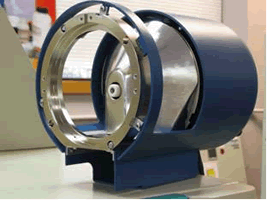KR Analytical
If a sample can be analysed at atmospheric pressure and not under vacuum, analysis time is greatly reduced because it is not necessary to wait for the sample region to pump down. Furthermore, biological samples can be analysed in conditions closer to their natural environment. Several ionisation techniques are now available to utilise this advantage.

DART
DART, Direct Analysis in Real Time requires minimal sample preparation. Simply position the sample in the gas stream and produce spectra. DART produces protonated molecular ions from organic molecules on, or close to a surface. DART operates in atmospheric conditions and requires minimum sample preparation and no specialist reagents. A gas supply is all that is necessary. After fitting the DART to a mass spectrometer, spectra are produced within seconds with minimum operator training. DART was invented by Cody and Laramee at JEOL Inc in the USA. It uses metastable helium atoms to ionise the sample. Because it is a very soft ionisation process, only protonated molecular ions are formed with no fragmentation, so interpretation is simplified. Identification and structures can be confirmed using either exact mass measurement or MSMS
Dart Features
- The simplest sampling procedure. Just hold the sample in front of the gas stream and acquire spectra
- No sample preparation is necessary. Solids, liquids and vapours can be analysed as seen
- No reagents or solvents are required. The only variable is the temperature of the gas stream. Once the correct temperature is achieved, spectra are produced instantaneously.
- Because there are no reagents, there are no background ions so everything detected originates in the sample
- DART can be fitted to an extensive range of mass spectrometers including ion-traps and triple quadrupoles
To date, DART has been used successfully to solve many real problems extremely rapidly
Applications Include
- Competitive Analysis
- PAT
- QC of active ingredients
- Rapid Analysis of LC Fractions
- Forensics
- Polymers & Packaging
- Odour Investigations
AP Maldi Ionisation

Atmospheric-Pressure MALDI has all the sensitivity of conventional vacuum MALDI but because it is not necessary for the sample to be under vacuum, changing sample plates takes a few seconds, greatly reducing analysis time. The Atmospheric-Pressure Matrix-Assisted Laser-Desorption Ionisation (AP-MALDI) source enables mass spectrometers fitted with an electrospray or nanospray source to have the additional capability of MALDI. It is called AP-MALDI because, unlike vacuum MALDI, ionisation takes place under atmospheric conditions. This provides several important advantages including convenience, speed of analysis, simplicity of operation and cost.
- Change between MALDI and ESI/nanospray in minutes. Calibrate in ESI and switch to MALDI without recalibration. Sample plates loaded in seconds as there is no waiting for vacuum to be achieved.
- MS-MS and MSn data (If instrumental capabilities permit) from a MALDI source for enhanced sequencing information at a fraction of the cost of a TOFTOF instrument.
- Superior performance, simpler operation and more reliable MS-MS capability than MALDI-TOF post-source decay (PSD)
- Robotic control of MALDI targets with CCTV point-and-click visual alignment checking for confidence in operation
- Windows control software interfaces seamlessly with existing control and acquisition software provided by instrument manufacturer to make operation simple.



